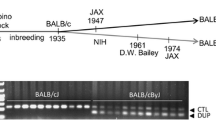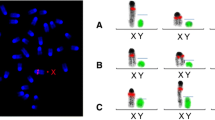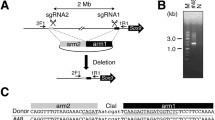Abstract
We have determined the order of a number of SSR and SSC polymorphic markers that map to distal mouse Chromosome (Chr) 4 and have used analysis of these markers in backcrosses designed to test the localization of the curly-tail (ct) mutation. We have confirmed that ct maps to this region, close to the locus D4Mit69. Our results also support the hypothesis that ct is a semidominant, rather than a recessive, mutation, since we have identified abnormal-tailed mice that are likely to be heterozygous at the ct locus. Finally, we examined Pax7 as a candidate gene for the ct mutation and found no evidence of protein sequence differences in ct compared with wild-type mice.
Similar content being viewed by others
References
Balling, R., Deutsch, U., Gruss, P. (1988). undulated, a mutation affecting development of the mouse skeleton, has a point mutation in the paired box of Pax1. Cell 55, 531–535.
Beier, D.R. (1993). Single-strand conformation polymorphism (SSCP) analysis as a tool for genetic mapping. Mamm. Genome 4, 627–631.
Beier, D.R., Dushkin, H., Sussman, D.J. (1992). Mapping genes in the mouse using single strand conformation polymorphism analysis of recombinant inbred strains and interspecific crosses. Proc. Natl. Acad. Sci. USA 89, 9102–9106.
Copp, A.J., Brook, F.A. (1989). Does lumosacral spina bifida arise by failure of neural folding or by defective canalisation? J. Med. Genet. 26, 160–166.
Dietrich, W., Katz, H., Lincoln, S.E., Shin, H.-S., Friedman, J., Dracopoli, N., Lander, E.S. (1992). A genetic map of the mouse suitable for typing intraspecific crosses. Genetics 131, 423–447.
Dietrich, W., Miller, J.C., Steen, R.G., Merchant, M., Damron, D., Nahf, R. Gross, A., Joyce, D.C., Wessel, M., Dredge, R.D., Marquis, A., Stein, L.D., Goodman, N., Page, D.C., Lander, E.S. (1994). A genetic map of the mouse with 4,006 simple sequence length polymorphism. Nat. Genet. 7, 220–245.
Epstein, D.J., Vekemens, M., Gros, P. (1991). Splotch (Sp2H), a mutation affecting development of the mouse neural tube, shows a deletion within the paired homeodomain of Pax3. Cell 67, 969–976.
Estibeiro, J.P., Brook, F.A., Copp, A.J. (1993). Interaction between splotch (Sp) and curly tail (ct) mouse mutants in the embryonic development of neural tube defects. Development 119, 113–121.
Gruneberg, H. (1954). Genetical studies on the skeleton of the mouse: VIII. curly-tail. J. Genet. 52, 52–67.
Hill, R.E., Favor, J., Hogan, B.L.M., Ton, C.C.T., Saunders, G.F., Hanson, I.M., Prosser, J., Jordan, T., Hastie, N.D., Heyningan, V.V. (1991). Mouse small-eye results from mutations in a paired-like homeobox-containing gene. Nature 354, 522–525.
Jostes, B., Walther, C., Gruss, P. (1991). The murine paired box gene, Pax7, is expressed specifically during the development of the nervous and muscular system. Mech. Develop. 33, 27–38.
Manley, K.F. (1993). Macintosh program for storage and analysis of experimental genetic mapping data. Mamm. Genome 4, 303–313.
Neumann, P.E., Frankel, W.N., Letts, V.A., Coffin, J.M., Copp, A.J., Bernfield, M. (1994). Multifactorial inheritance of neural tube defects: localization of the major gene and recognition of modifiers in ct mutant mice. Nature Genet. 6, 357–362.
Straaten, H.W.v., Hekking, J.W., Copp, A.J., Bernfield, M. (1992). Deceleration and acceleration in the rate of posterior neuropore closure during neurulation in the curly tail (ct) mouse embryo. Anat. Embryol. 185, 169–174.
Straaten, H.W.v., Hekking, J.W., Consten, C., Copp, A.J. (1993). Intrinsic and extrinsic factors in the mechanism of neurulation: effect of curvature of the body axis on closure of the posterior neuropore. Development 117, 1163–1172.
Walther, C., Guénet, J.L., Simon, D., Deutsch, U., Jostes, B., Goulding, M.D., Plachov, D., Balling, R., Gruss, P. (1991). Pax: a multigene family of paired box-containing genes. Genomics 11, 424–434.
Author information
Authors and Affiliations
Rights and permissions
About this article
Cite this article
Beier, D.R., Dushkin, H. & Telle, T. Haplotype analysis of intra-specific backcross curly-tail mice confirms the localization of ct to Chromosome 4. Mammalian Genome 6, 269–272 (1995). https://doi.org/10.1007/BF00352414
Received:
Accepted:
Issue Date:
DOI: https://doi.org/10.1007/BF00352414




